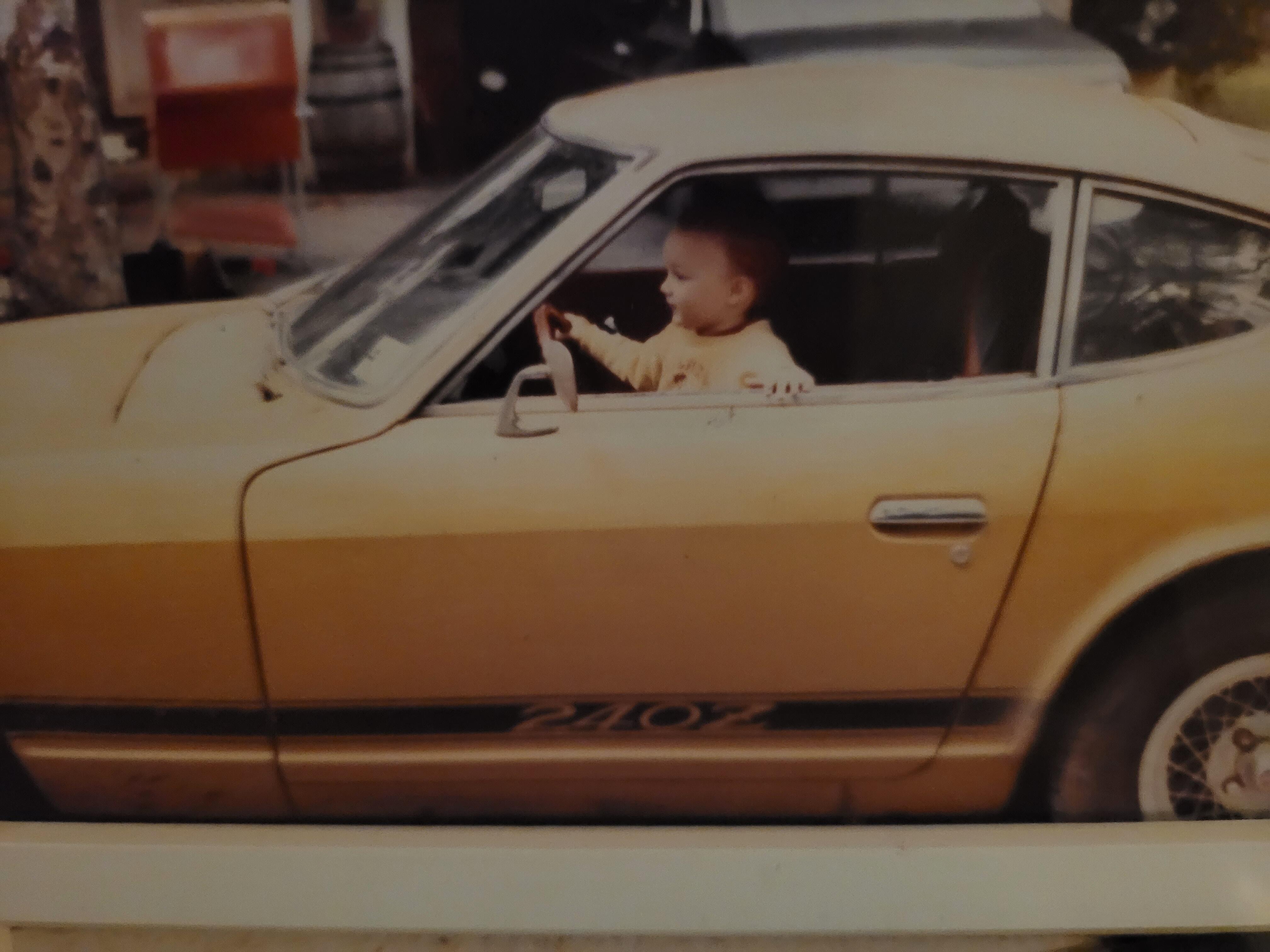
Paulytunes
 Subscriber
Subscriber
-
Joined
-
Last visited
Posts posted by Paulytunes
-
-
-
Edited by Paulytunes
Update: My 280Z will not start. I am getting 0 PSIG on the fuel pressure gauge on the fuel oil supply line. I was able to source a replacement fuel damper and plumbed up everything. Troubleshooting per the Fuel Injection and Factory Service Manual led me to find the following:
All wiring connections are as intended - I did not find any plugs or harnesses disconnected.
The fuel pump is not getting power when I start the car.
No voltage is present at the fuel pump across the power and ground terminals when the key is in the "On" position.
No voltage is present at the wiring harness under the passenger seat at the green wire and black ground when the key is in the "On" position.
The fuel pump relay clicks when I try to start the car.
The fuel pump operates when I run a direct line from the positive battery terminal to the pump.
All of troubleshooting checks from the "Engine won't Start" section of the Fuel Injection Bible pass and my efforts lead to quote "try a different ECU."
I was able to source a second ECU on eBay, but it yields the same result.
My taillights and license plate lights do not work (not getting power).
Running a separate ground wire from the fuel pump negative terminal to a chassis ground does not resolve the no starting condition.
Based on my findings above, I am not sure what my issue is or to diagnose why I am not getting any power to the pump. Anyone have a similar problem and can diagnose?
I thought maybe it was a bad ground, but wouldn't the separate ground wire have resolved the problem? From what I understand, the main ground that the fuel pump, taillights, etc. are connected to requires removal of the gas tank to access. I was hoping to avoid this, but if it is my next step, so be it.
Also, when the previous damper failed, it did drip gasoline on to the pump and terminals. This is because on 1976 280Zs, the damper is above the pump and the whole kit (damper, pump, hoses, wiring) is mounted to an L shaped bracket that is mounted with three screws to the chassis. This was changed in 1977 and 1978 models to a flat plate that mounts to the chassis but places the damper and pump side-by-side. I'm guessing this was an improvement that would have reduced the possibility of a failed damper leaking fuel onto the pump. Could that wetting of the pump terminals have ruined my ground wire or power wire to the pump?
How likely is it that my remanufactured aftermarket ECU and the eBay replacement (which was started to be from a 1976 2+2 4 speed, just like mine) are both bad and presenting the same exact issue?
-
Edited by Paulytunes
additional infoI should also mention that my 280Z does not have the vacuum switching valve shown in most of the diagrams and photos I have seen in the FSM, other manuals, photos, etc. It seems one of the previous owners removed it. Is there a vacuum line that should be connected to it, and if so, should I plug that if the vacuum switching valve isn't there? I wouldn't think that this would cause my current issues.
But it does appear that this was the vacuum line that the previous owner placed on to the dashpot nipple.
-
Edited by Paulytunes
Over the past few months, I have been trying to continue to troubleshoot my high idle issues. I had it parked and applied throttle. It was stuttering and backfiring at high rpms, and then I noticed a hissing sound coming from the rear. I looked below, saw a puddle of gasoline on the garage floor, and found that my fuel damper had sprung a leak. This is the second one to fail since I replaced the aftermarket fuel pump with a slightly used OEM fuel pump.
I came to find that the fuel dampers are incredibly hard (if not impossible) to find. It looks like the damper is no longer manufactured. An internet search revealed that these were also used on BMWs. But any mention of these 3 letters in the part search seems to add a 3x multiplier to the cost and it is also not available after hours of scouring the internet. So I ended up buying an aftermarket damper from Z Car Depot and made by Radium Engineering. Once I had the aftermarket damper in hand, I plumbed everything up and resumed troubleshooting.
The new damper fixed the high idling problem, as it only idles high when cold, but then eventually settles down to ~800rpm when warmed up. It has a hard time keeping from stalling once the idle drops, and this is regardless of what adjustments I make to the idle speed screw. Applying throttle leads to backfiring and stuttering around 3000rpm, usually followed by a stall. This was the status yesterday.
I troubleshooted more today and noticed that I somehow was missing the Air Flow Meter ground wire connection, so I fixed that. Now when I try to start it, I can get it to start, but stalling is almost immediate. Also, applying throttle has no effect, other than forcing a stall. I also noticed the pressure gauge I installed between the fuel filter and engine fuel supply tubing is now frozen at 10 psig. I also read through the "Purs like a kitten thread" (sic) and other threads found by searching, tried much of the troubleshooting in the FSM and Fuel Injection Bible, and other service manuals, but I have not been able to find a smoking gun or root cause of my issue. I can certainly relate to all those "that have been to hell and back with the factory EFI system," as someone said in one of the numerous posts I read. I am also beginning to think either my 280Z or I am cursed. Anyone know of a good Datsun mechanic in the Baltimore, MD area? I don't want to give up, but I am starting to lose hope.
-
-
15 minutes ago, Zed Head said:
That nipple shouldn't have a vacuum source connected to it, it should be open to the air. It's a common mistake. Don't know why Nissan designed it that way.
A common problem with the pre-77 throttle bodies is that the blade gets gummed up and sticks open. You might check that. Next time it hangs at 2000 pull up on the throttle pedal with your toe or open the hood and press the linkage closed.
Another possibility is that the return spring rusted and broke. It's hidden away, low and behind the TB. Can't remember if you already addressed that possibility.
Finally, the other "hanging high" problem is caused by the BCDD.
Here's a drawing of the dashpot with no hose connected.
Thanks, I'll look into that. So should that vacuum house then be open to the air or connect to something else that I am not seeing? There's a three way tee, which was always connected to the dashpot nipple, a vacuum port on the bottom of the AFM, and also to the charcoal canister vent on the other side of the engine bay.
The dashpot connection does indeed seem to be common, many other L28 engine photos online show it connected.
-
So after much trial, error, troubleshooting, and going through the Fuel Injection Bible and FSM, I was able to get my 280Z running again. The issues I have now:
-
I stupidly broke the plastic nipple on the stall dashpot while connecting the thermostat sensors and wiring:
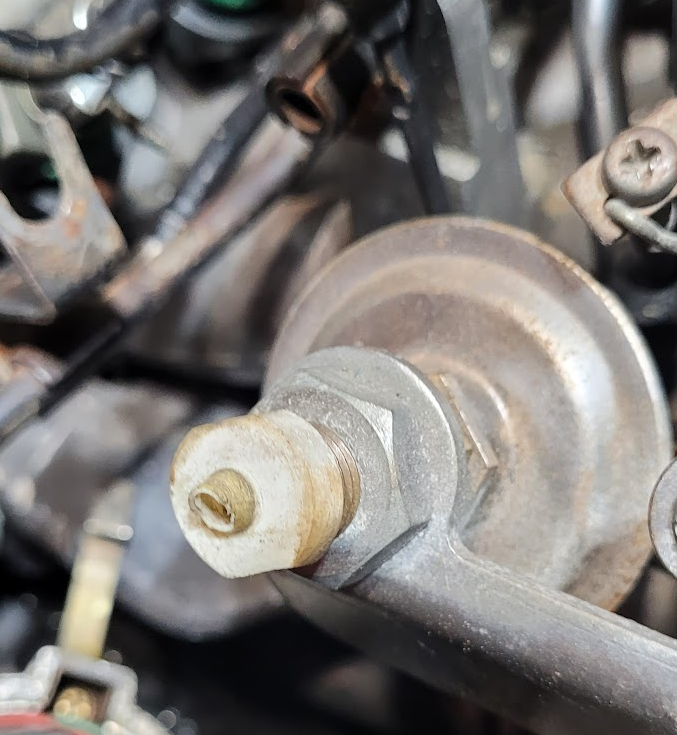
- Idling is pretty high, around 2000rpm at cold start. Occasionally, it will adjust down to 700 to 800 rpm and will sometimes stall. Other times it will stay at 2000 rpm, unless I drive it and can force the RPMs lower with the gearing. When I take it out of gear, it shoots right back up to 2000 rpm. May be due to the temps here, which were between 55 and 60 degrees F today.
I was able to temporarily fix the dashpot and reconnect the vacuum hose to it using a smaller diameter tube to insert into the part of the intact plastic and the vacuum hose until I can source a new dashpot assembly. I'll continue to diagnose the high idling and see if this is due to something I am overlooking or a symptom of my rebuilt ECU not performing up to OEM standards.
-
I stupidly broke the plastic nipple on the stall dashpot while connecting the thermostat sensors and wiring:
-
10 hours ago, Zed Head said:
I found your Ford doppelganger from 2021.
https://www.ford-trucks.com/forums/1656335-91-f150-losing-spark-intermittently.html
"There is nothing I could find on the Computer that indicated where it came from or what calibration it is for. The only thing it had was a QR code that directed me to a site called "installapart" but the site itself looked closed."
Zed Head - that is Interesting, thanks for finding that site. The OP never does say what he did with the ECU.
-
10 hours ago, SteveJ said:
You can see the site using the internet wayback machine: https://web.archive.org/web/20180307072216/http://www.installapart.com/
Thanks! This was certainly an unexpected and unfortunate discovery. I wasn't able to track down how to troubleshoot the ECU - those pages are probably long gone or that institutional knowledge died when the company went 6 feet under. I have had nothing but trouble with aftermarket parts that one of the PO's installed - first the fuel pump now this. I guess I am at a crossroads - Do I try to source a working 1976 Datsun 280Z ECU, go down the Resto mod path of installing a FAST ECU or other replacement system, or continue to struggle and troubleshoot with what I have (even though it may be an exercise in futility)?
-
So as I continue to troubleshoot, I pulled out the ecu to inspect it. When I unscrewed it and examined it, I noticed a qr code. When I scanned it, I am sent to a website that no longer exists. The website was Installapart.com. It appears that Installapart is no longer in business. Were they a rebuilder of ecus? Why did they go out of business? Has anyone here ever heard of Installapart or used their ecu services?
-
Edited by Paulytunes
1 hour ago, Zed Head said:Not clear what you mean when you list those numbers. The first three pairs are AFM pins. Were you doing the AFM test procedure? Not uncommon to have the plug fall off of the bottom of the AFM, since gravity is pulling on it and the clip sometimes doesn't get clipped in when you reinstall the AFM.
It might just be that the AFM plug fell off of the AFM and the bullet connector over the intake manifold for the coolant temperature sensor is unplugged. One big plug and one small one.
I decided to go back to the beginning of the 1976 FSM (Page EF-21) and attempted to diagnose why the engine cranks but won't start. It listed the AFM test first, so I went ahead and did that. I skipped over the fuel pump (since I recently replaced it), and then moved to the water temperature sensor test. I checked the connections at the AFM and Water Temp Sensor, both were snug. Bullet connections are snug too. I'm at a loss as to why I am not getting any continuity unless I am either doing the test wrong or I managed to really fry the wiring after I accidently and inadvertently wet the connections and burned up the fusible links.
-
Update: so I tested the temperature transmitter. It has the appropriate resistance for the coolant temperature.
However, when I test the connection pins at the wiring harness, I get zero continuity. This is for pins 6 and 8, 7 and 8, 8 and 9, and pin 13 and ground. This leads me to believe that maybe the wiring harness is possibly bad. Could I have ruined the whole harness when I unintentionally gave the lower thermostat housing wiring connections a coolant shower and blew out my fusible links?
If so, I feel like an idiot and that one's partially on me. Also partially on whichever previous owner decided to over bore the thermostat bolt, and Nissan for using non-waterproof electrical connections under a gasketed connections for coolant. 🤦♂️
-
8 hours ago, Zed Head said:
The FSM instruction comes after the test of resistance at Pin 13 at the ECU connector. The assumption is that the temperature circuit is complete and working correctly all the way to the ECU. You need to be sure that the ECU is getting the proper information. Measure resistance at the pins and compare to the table of resistance versus temperature.
From the 1981 Guide -
Thanks! I will test the resistance at the ECU next. I'll be looking for a higher resistance reading since it is starting to get cooler here and my garage is not insulated.
-
10 hours ago, Yarb said:
There are folks here on the forum that have tested factory ECU’s and have them as spares. As far as the fast EFI system I’ve heard very little other than a friend on the forum tried it and it did not go well for him. I would reach out and see what you can find here on a tested ECU that someone has in their stash. Again the longevity of a replacement is hit and miss but I would definitely try that first IMHO.
That's what I was afraid of - the Fast EFI almost looks too good to be true. I also really don't want to stray too far away from stock if I can help it.
-
So I was running fine through most of the summer, until mid-August when one of the connections to the water temperature sensors broke while I was on my way to support a Cub Scouts event and show the kids my 280Z.
Since I was going to be sidelined for awhile waiting for the new switch to arrive from Z Car Depot, I decided now would be a good time to flush out the coolant, replace the thermostat, etc. No good deed goes unpunished. I found one of the thermostat lower housing bolt holes to be over-bored and filled with thread sealer:
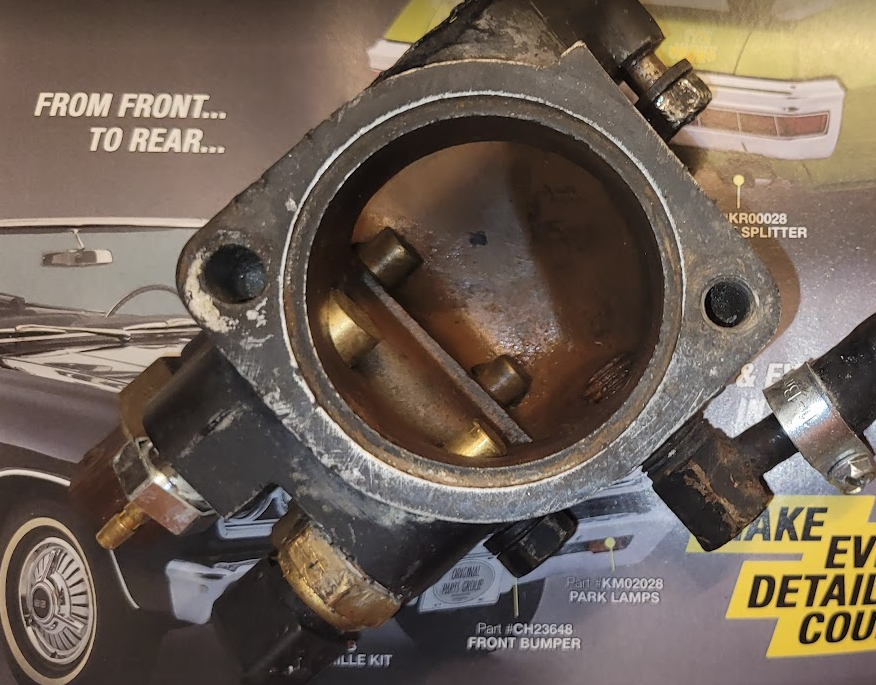
Of course I discovered this after I had reconnected everything, got my 280Z to start, and then when the T-stat opened, it showered the connections and proceeded to cause a short and burned up my fusible links.

So, I ended up ordering a new fusible links, a lower housing, and other parts and again was waiting for them to arrive. I got everything back together and it started but was really rough. I thought maybe I had swapped the thermo-time switch and water temperature sensor connections, but after tracing the wires back using the FSM and 1976 wiring diagram, I verified all was connected as it should be. When the engine is cold, it will start but idle really rough then eventually dies after a minute or two or applying throttle.
I did the light test today from page EF-51 of the 1976 FSM, and I notice that there is no difference in brightness from the flashes of the light when cranking when the cold start valve is connected and removed. This was witnessed on the No.1 and No.4 injector connections, as the FSM instructs. The FSM states "if the lamp does not flash, or if the lamp does not become brighter when the cooling water temperature sensor harness connector is removed, it indicates that the control unit is faulty. Replace the control unit, and carry out the inspection again as described above."
So my questions are:
1. Is there any other quick ways that I can determine that my ECU has failed.
2. Assuming I have a bad ECU, what is the reliability of used ECUs? Are they similar to the Transistor Ignition Unit where a used one that I find (I assume there is no more NOS available from Nissan) will be living on borrowed time and I could expect to have the same sort of failure at any given time, whether it is days, months, or years down the road?
3. If #2 is true and used ECUs will fail, has anyone tried the FAST EFI ($1,600) or other more reliable/modern fuel injection system that can chime in on their experience and whether this is a recommended option or not?
Thanks in advance for any input you may have and thanks for reading.
-
On 7/3/2024 at 7:10 PM, Jeff Berk said:
Although I'm constantly tinkering with my '74 260z, I find it very rewarding when I make a discovery, learn to do something new, or fix a system that I never knew how to fix. I definitely spend more time under the hood than in the driver seat.
I was reminded of how enjoyable it is working on this Z today when my 10-yr-old Chevy Volt stopped recharging and I had to take it to a dealer. My OBD II scanner could not read hybrid codes because I needed the $5K unit to read the recharger module codes. The dealer charged me $180 to start diagnosing the problem then told me to continue trouble shooting the problem I needed to give them $700 more. The cause of the problem was one of three issues. The cost for the most likely problem, a recharge control module, would end up costing me $3K+ to replace. This on a car worth $4K.
I got lucky and after the 1st $180, I called a small repair shop within walking distance of my home and found out that he has personnel trained in working on rechargeable hybrid cars. I'll still have to pay $1.2K for the part, but I can avoid the near $200/hour labor.
I think you hit the nail on the head. I'll add that I think the S30's are very well engineered cars that can be worked on with a good set of metric tools and without many specialized tools. My 280Z also doesn't generate the same level of frustration of other older cars that I have owned. Caution: I may be biased and have an unnatural love for Japanese cars. There's no cost cutting measures that are prevalent in American cars (nothing frustrates me more than finding something stupid, like a $75 relay buried behind a dashboard assembly or door handles that just fatigue and break repeatedly, or overheating problems that never go away), no inherent complexity or need for special tools like German cars require, or reliability issues with other European makes. The only issues I have found is that my clumsy, large American hands are often too big to fit in small spaces.
I think I said it before, but Japanese cars built up to around the mid-1990's were probably the pinnacle of automotive engineering, and that likely started somewhere around the time of the S30. Unfortunately, this golden age ended in before the new millennium, when Japan started playing the same game that all the other manufacturers do now, with impossibly difficult maintenance items, needless plastic and foam rubber coverings in the engine bay, technology that becomes obsolete in a few years, and components with limited lifespans only designed to last until the warranty expires.
It is a joy to open the hood of the 280Z and just look at the L-series inline 6. I also love explaining to my kids or whoever else will listen what each component does and how it functions. I have become somewhat of a self-taught expert, using my mechanical aptitude, reading the factory service manual and fuel injection bible, and also with the help of the great members and resources of this forum. They no longer make cars like the S30 and never will again, which is why I intend to keep mine alive and driving for as long as I am able, as well as trying to cultivate and grow interest with my kids. The next generation will likely not understand how to drive a car with a manual transmission, or without backup cameras, blind spot warning lights, lane assist, traction control, power steering, and all the other electronic nannies that are present on modern cars.
-
So not the triumphant update that I was hoping to write this evening, but I did get closer to resolving my fueling issues. I'm pretty sure I have said it before, but I do absolutely love this site and all the helpful members.
I was able to obtain a Nissan fuel pump and damper from a fellow member here that no longer needed the setup. This made me extremely happy, as I want to keep my 280Z as close to stock as possible, and I did discover a problem with my damper.
I installed the new-to-me fuel pump on Friday and was able to test start the car on Saturday. It only took a few seconds to start! After warming up, a few throttle pushes to redline, and I had no more hesitation, and fuel supply pressure was right where it was supposed to be around ~35-36 PSIG. I think my whole neighborhood heard my shouts of jubilation. I then went to the rear of the car to check for leaks and found a steady stream dripping from above the fuel pump and into my bucket. I shut the car off and found my damper to be leaking. Luckily, I had the replacement one on hand, so I had to disassemble everything and install the other damper. I suspect my existing damper was on its way out, and the increased pressure from the factory pump (remember the aftermarket one that was installed by a PO registered around 12 PSIG less than OEM) blew a seal or something out? Anyway, everything is back together, but I am now waiting on an appropriate fuel line clamp at the pump discharge (PO used the wrong type and all the spare correct ones I have are too small), which should be here tomorrow.
-
On 6/24/2024 at 2:25 PM, Zed Head said:
The check valve might be stuck. Maybe you can poke it free, if so.
On your puddle of gasoline - you got really lucky. I hope that is a detached garage. If not, you almost burned your house down, and killed your dog. People should stare at that picture for a while and imagine. It will be incentive to be cautious and think about consequences. You dodged a disaster.
Sorry to be critical but sometimes we forget.
I certainly had a Guardian Angel watching over me that night. Not that it makes it any better, but there was about 5 gallons of gas in the tank at the time of the incident.
-
-
So, today was a comedy of errors. I removed the pre-filter and tried to prime the new fuel pump again. No fuel flow came out of the discharge. Just for shits and grins, I decided to reinstall the old pump to make sure that I wasn't screwing something up. The old pump re-primed without issue and within a few seconds. It seems likely that I was sent a defective fuel pump. Around this time, my wife wants to go out to dinner, so I set the old pump on the ledge of the bucket I was using to catch the fuel from my disconnection and reconnection activities and go to wash up so that I can go to dinner with my wife and kids without reeking of gasoline.
We get to dinner, and my son says he feels dehydrated and not well. Just as we are about to get seated, he gets as pale as a ghost, and my wife, with her mother's ESP/intuition/sixth sense, ushers him out the door, where he proceeds to vomit at the entrance of the restaurant. Needless to say, we came home. Upon opening the garage door, we discover this:
The fuel pump had fallen off the bucket ledge (probably when we closed the garage door or sometime there about), into the bucket, and proceeded to drain my tank into the bucket and then slightly overfilling on to the garage floor and scrap cardboard that I was using for minor fluid spills. I think I can safely rule out that there is any issue within the tank. 🤞 To top it all off, when we went inside, our dog was excited and choking on something she decided to chew on while we were out. She cleared it and was okay after a few scary seconds. This is certainly a night I won't forget anytime soon! 🤣
After spending the better part of the evening cleaning up the garage and trying to get rid of the gasoline odors, I came to the realization that I really want a lift and I am back in the market for a fuel pump.
-
-
18 minutes ago, Zed Head said:
Which pump did you get? You ID'ed the old one but not the new one.
There's no reason to start the engine to get the pump to work. It will flow fuel all day if battery power is supplied. You can do that by removing the yellow wire at the starter solenoid and turning the key to start, or by taking the cover off of the AFM and moving the weight off of the fuel pump contact lever with the key on.
The new one is an Autobest F4239 E8228. It has a straight discharge instead of the 90-degree upwards discharge. I probably should have looked a little closer before purchasing and trusting the "will fit your vehicle" confirmation on Amazon.
-
8 hours ago, Zed Head said:
Any chance that you have the pump installed backward? They typically have a check valve on the outlet end.
Also, if you wire it backward it will spin backward.
If it was mine, I would disconnect the hose from the tank and see if fuel flows freely. If it does, then reconnect it to the pump and disconnect the outlet side of the pump. Gravity should fill the pump and fuel should come out of the outlet of the pump through the check valve. That would be the priming step. Once it is full of liquid it should push it up to the filter and rail.
I checked both orientations, no flow through the pump after multiple attempts. I wired it up to match the replacement pump, 1976 wiring diagram, and the FSM - green is positive, grey/black is negative. I verified the pump is getting power.
Fuel does seem to flow pretty freely out of the hose when I disconnect the prefilter. After thinking about it, I am wondering if the issue may be the prefilter. I may just connect the outlet hose to the pump inlet and see if that works. The pump installation instructions say to prime it by starting the car without the pump outlet open and verify fuel flow out of the pump discharge.
-





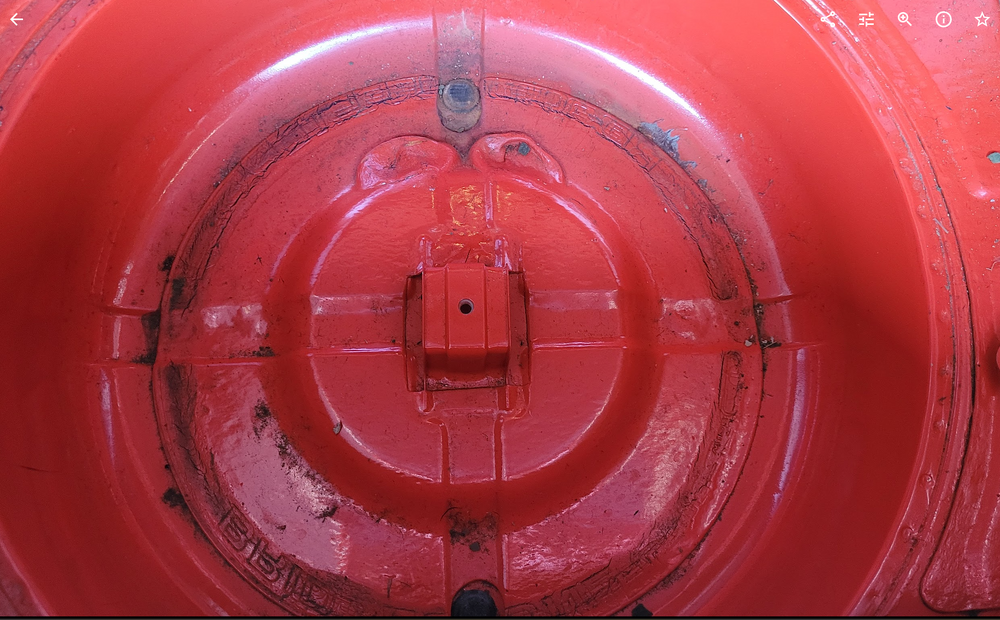
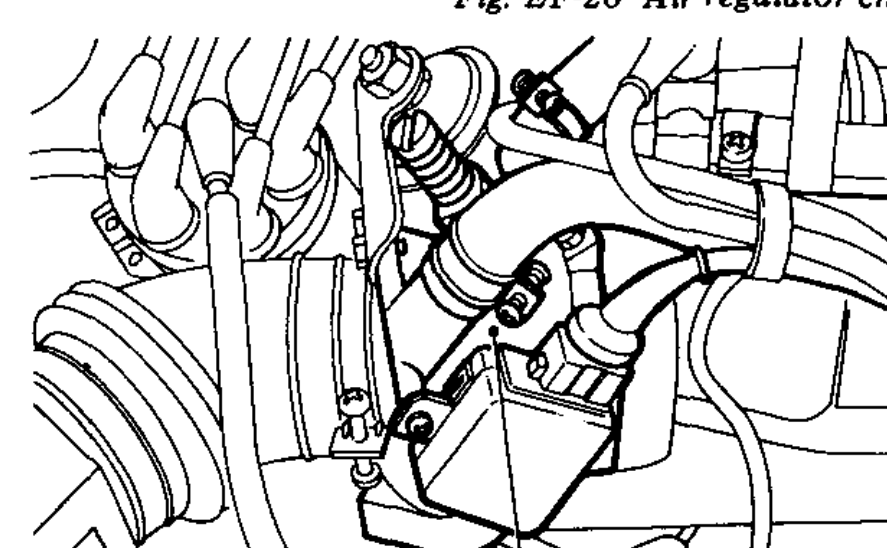
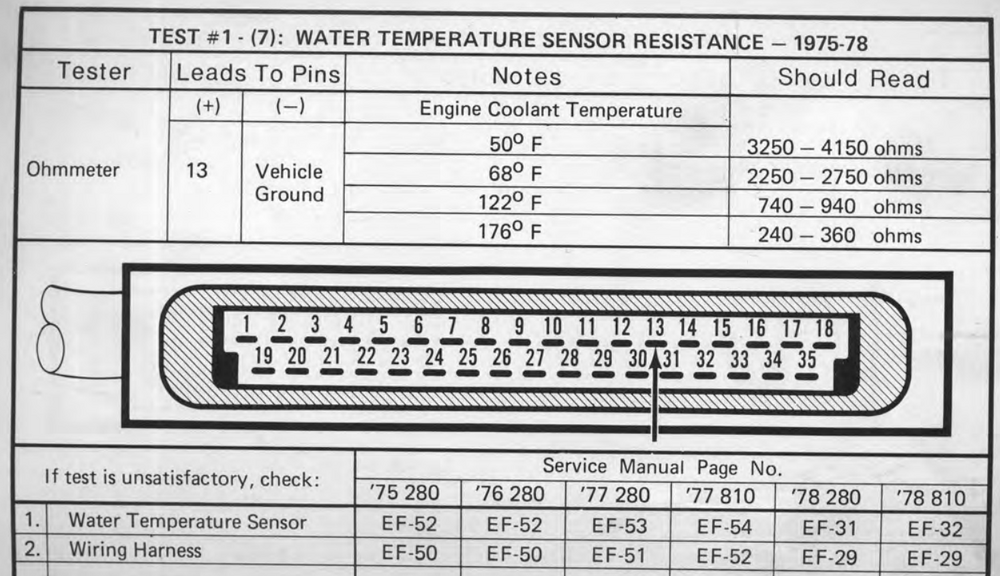

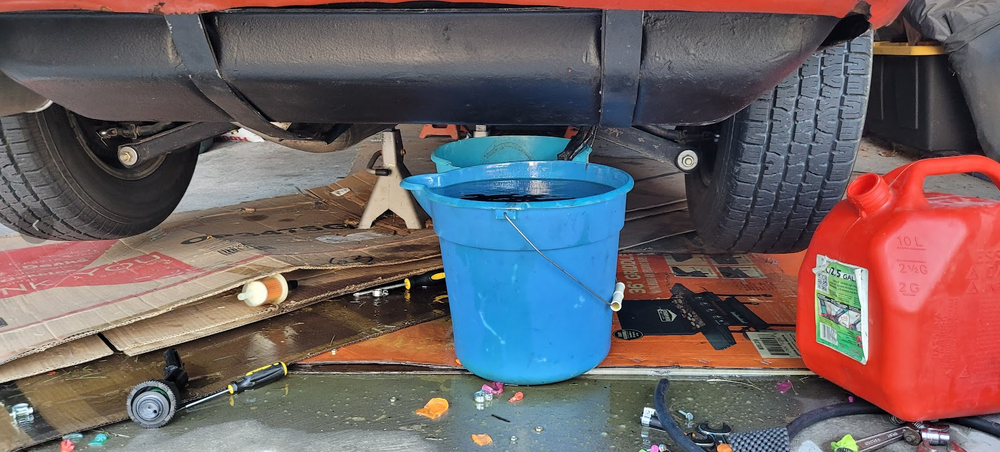

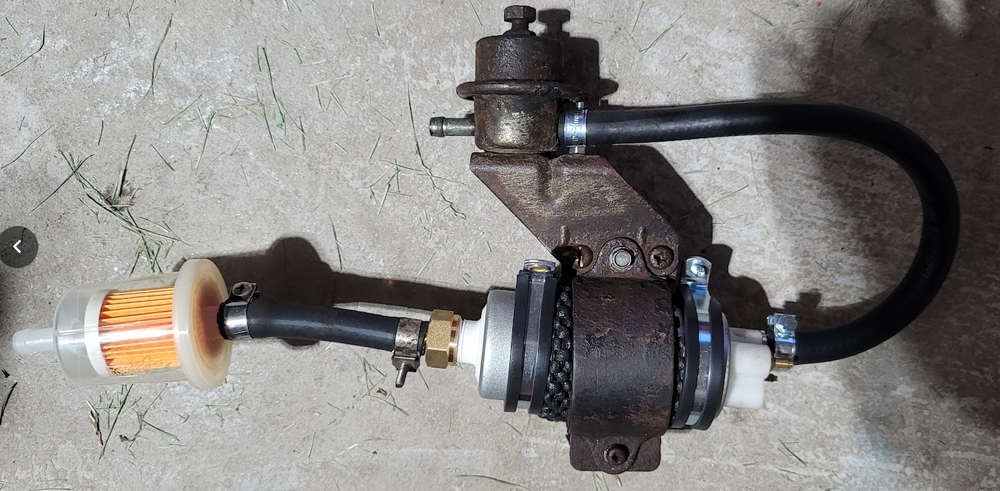
1976 280Z Fuel Issues Troubleshooting
in Fuel Injection
·
Edited by Paulytunes
Thank You!!! I was finally able to source a Bosch plastic housing replacement relay on eBay marketed as a VW part. It arrived on Tuesday, and I installed it today. I knew that was it when I turned the key and heard the hum of fuel pump. Once I added some fresh fuel to the tank, I turned the key, watched the fuel pressure gauge climb up to 36 PSIG, and the L28 started and ran! I do need to still do some troubleshooting and fix the backfiring and high idle, but those seem like much smaller challenges now that I have a running car again. Apologies to my neighbors, I think the whole community heard my hollers of joy and elation when the Z fired up this afternoon! A small victory, but a much-needed win for me today with all that has been going on at work.